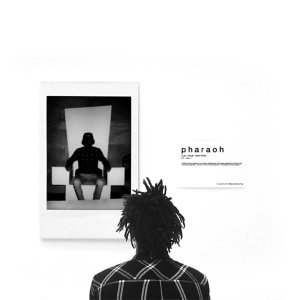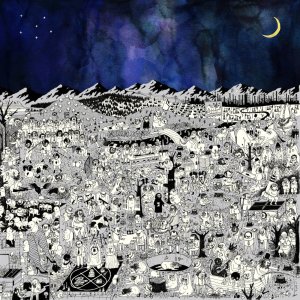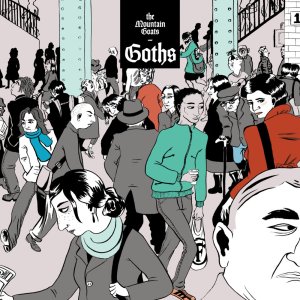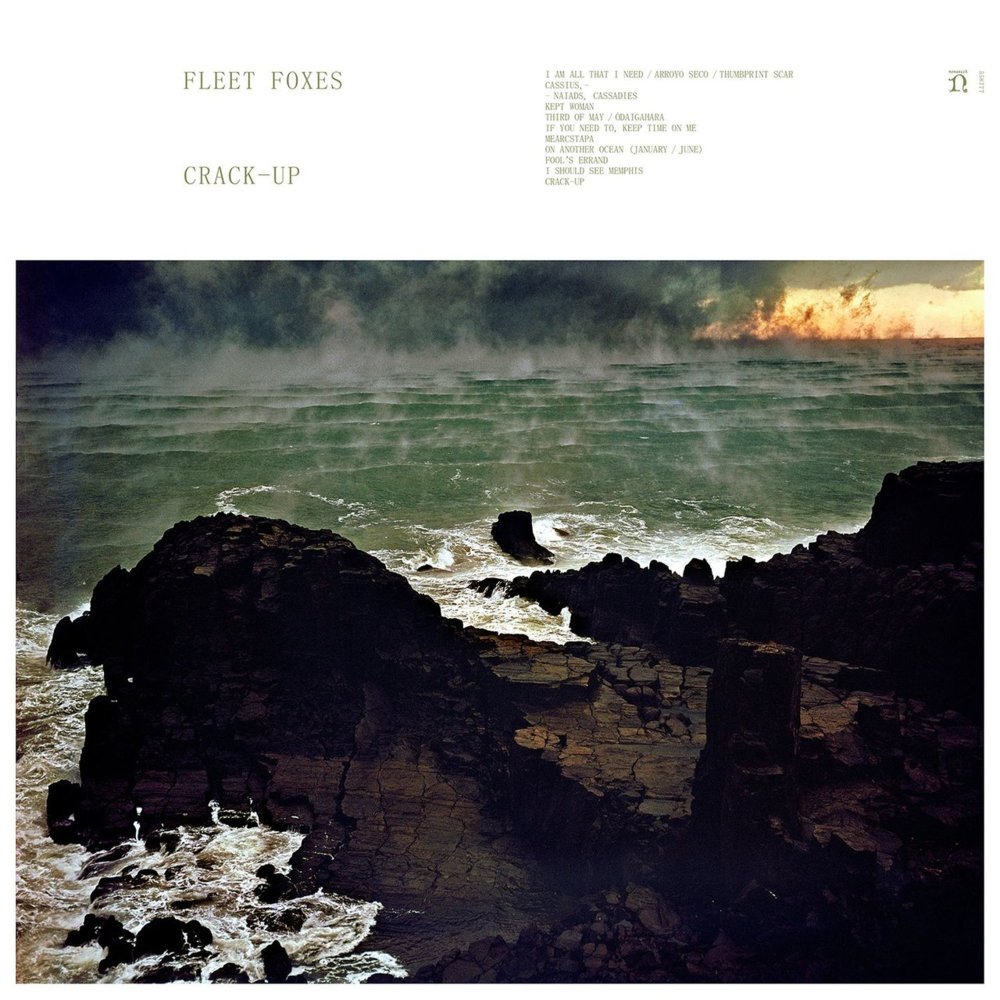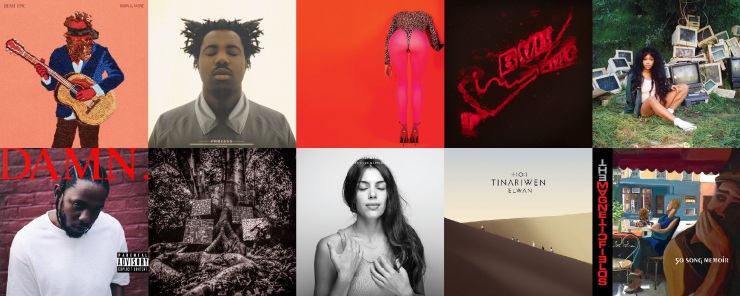
Woof.
There’s certainly no need to get into how devastating and horrifying a year 2017 was. But no matter how much darkness enveloped us, the world of music was able to offer us at least a bit of solace in the form of powerful, affecting art from scores of ingenious artists. In a time when deviation from the norm seemed to be punished more harshly than ever before, the microcosm of indie rock was for once dominated by women, musicians of color and LGBTQ+ folk – from Vagabon and Girlpool to Jay Som and Julien Baker – yielding truly extraordinary music that broke down barriers and gave voice to the voiceless. Feminist anthems like Cardi B’s ferocious “Bodak Yellow” and Kesha’s rip-roaring “Woman” hit the airwaves just in time for the great reckoning of the #MeToo movement. We lost a host of luminaries, but were in turn greeted by throngs of new talent – as well as the welcome return of a few old friends (Fleet Foxes, Slowdive, and Grizzly Bear, just to name a few.)
What follows is an assortment of records that had the strongest impact on me over the past year. Albums that stunned me with their lyricism, their beauty, their complexity, their bravery. Albums that made my unending obsession with music in all its forms feel worthwhile. It’s hard to say what will be in store for us in 2018, but here’s hoping that, as we continue to fight the good fight, we’ll also continue to believe in great art – and in its power to unite us and reaffirm our humanity.
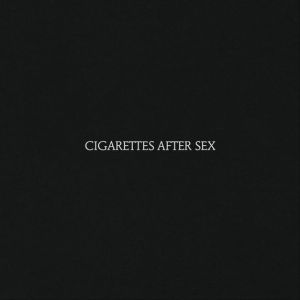
25
Cigarettes After Sex
Cigarettes After Sex
Partisan
There’s an uncanny, Lynchian quality to the airy, sensual dream-pop of Cigarettes After Sex. Their full-length debut finds the group perfecting the layered slowcore/shoegaze-influenced sound they’ve been developing since its inception a decade ago. Greg Gonzalez sings in an aching, lovestruck half-whisper as he and his bandmates use jangly, echo-laden guitars and gentle drum beats to craft music that recalls Heaven or Las Vegas-era Cocteau Twins, constantly maintaining its intimacy yet managing to soar to breathtaking heights. Ten years, of course, provides time for plenty of living, and Gonzalez’s growth as a songwriter is evident. His lyrics comprise a series of quietly mesmerizing confessional tales of 21st-century love, packed with noir melodrama and self-deprecating humor. Calling an unfaithful ex “the patron saint of sucking cock” would sound unwieldy in almost any context, but when Gonzalez does so in “Young and Dumb,” it’s a wry comment on the fluid, no-strings-attached nature of the modern relationship. “Truly,” he croons on “Truly,” “know that you really don’t need/To be in love to make love to me.” Equal parts swooningly romantic and effortlessly hip, Cigarettes After Sex is a masterful exercise in passionate restraint.
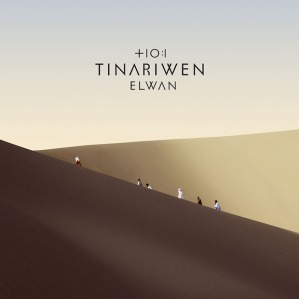
24
Tinariwen
Elwan
Epitaph / Anti-
The Malian outfit, now nearing its fortieth year of existence, presents on Elwan some of their angriest, most electric music yet. Jagged Saharan blues riffs slither hypnotically over rattling, argumentative percussion and throngs of backing vocalists as co-founder Ibrahim Ag Alhabib’s weary, trance-like voice laments the political and social unrest he has witnessed firsthand. “Love these days is like a mirage,” he intones on “Arhegh ad annàgh.” “It gets fainter the closer you get.” The lyrics are mournful and the music often caustic, but it never ceases to be a thing of profound power and beauty to hear these many seemingly disparate elements – which here also include contributions from Western musicians like Alain Johannes, Mark Lanegan and Kurt Vile – join together in an immaculately arranged tapestry of sound. It’s appropriate considering the band’s beginnings as a collective of grassroots rebels, joining together in the hopes that one day the peoples of the world might live in peace.
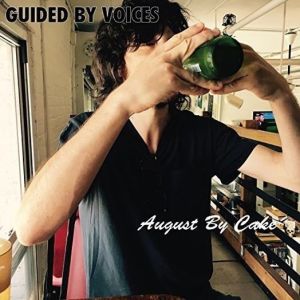
23
Guided by Voices
August by Cake
Rockathon
August by Cake isn’t just Guided by Voices’ best album since Robert Pollard resuscitated the project (for the first time) in 2010 – it ranks up there with some of the best they’ve done, period. After plodding along in complacency for a near half-decade and cranking out a slew of competent but ultimately lacking records, Pollard and co. sound utterly replenished on this sprawling, 32-track set – like they’ve rediscovered the energy, joy and eccentricity that fueled mid-90’s masterworks like Bee Thousand and Alien Lanes. They leap gleefully from the brassy, Arthur Brown-esque power-pop of “5º on the Inside” to the stoner-metal mutation of “Packing the Dead Zone,” from the raucous, doom-ridden schoolteacher narrative “Substitute 11” to the tense serenity of “Sentimental Wars.” Pollard proves that his acerbic wit and idiosyncratic sense of humor haven’t entirely dulled after 30+ years and 100 LPs, and his bandmates (which this time around include Bobby Bare, Jr. and Nada Surf’s Doug Gillard) adeptly demonstrate their own songwriting chops. Whether the glorious momentum the band has established here will endure over the next 100 inevitable releases remains to be seen, but for now – goddamn.
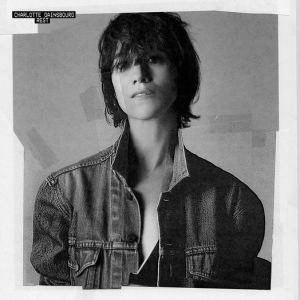
22
Charlotte Gainsbourg
Rest
Because
There are those that would relegate Charlotte Gainsbourg as an artist to a place in the shadow of dad Serge, and to them I say, casse-toi. With the darkly sumptuous Rest, her first album in six years, the multi-hyphenate permanently cements her own artistic vitality and depth of vision. Producer SebastiAn (with help from Danger Mouse, Daft Punk’s Guy-Manuel de Homem-Christo, and orchestral dynamo Owen Pallett, among others) constructs delectable, scintillating walls of ominous chamber pop and foreboding disco that engulf (but by no means inhibit) Gainsbourg’s lyrics and breathy, dramatic vocals. Every second on Rest is flooded with apocalyptic drama as Gainsbourg examines the deaths of two family members (her old man and half-sister Kate Barry) and muses on the horrors of addiction. She recalls curling up next to Serge’s corpse as a teen on “Lying with You” (“Where did my kiss go when the coffin shut?/I always hear the beating of nails/You lost, I’m distraught”) and attempts to revive the spirit of “Kate” via song; “Deadly Valentine” is a skewered set of wedding vows, while “Sylvia Says” channels Plath’s “Mad Girl’s Love Song” to spellbinding effect. Gainsbourg’s welcome return to music is a thing of terrifying power; rarely has an album about death been so angry, so cool – and so effective. À votre santé, Charlotte.

21
Iron and Wine
Beast Epic
Sub Pop
Sam Beam’s sixth album as Iron and Wine eschews the jazz-pop trappings of 2013’s Ghost on Ghost for something of a return to form, compiling a dozen lovely, gentle little folk tunes that strike a middle ground between the starkness of Our Endless Numbered Days and the lush orchestration of The Shepherd’s Dog. His arrangements are ramshackle yet airtight, with divergent fiddle and keyboard and guitar and drum lines joining together smoothly as one in that magical way only Beam can make possible. Right out of the gate, we’re greeted by his whispery voice, like the welcome call of a long-lost friend, as he uses his distinctive lyricism to spin yarns inspired by his own fascination with the passage of time—and all the beauty and pain it squeezes into the brief span of our lives. As he advises on the downright enchanting “Call It Dreaming,” we face plenty of hardships during our time on Earth, but we’re all still together at the end of the day—and if we seek to make the most of life, we need only take the good with the bad and chalk it up to experience (the essence of life itself). Clocking in at just under 36 minutes, Beast Epic is bittersweet, almost frustrating in its brevity—we’ve no choice but to listen close and hold on to whatever bits of luscious melody and lyric we can. Doing so, over and over, we ultimately realize that the “beast” Beam speaks of is us – this is our story, our epic.
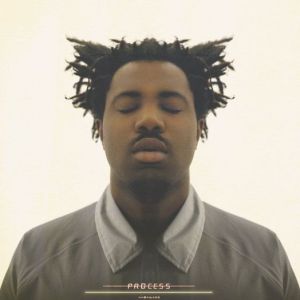
20
Sampha
Process
Young Turks
London’s Sampha Sisay made a name for himself with the soul-baring bedroom recordings that rightfully caught the attention of high-profile collaborators like SBTRKT, Drake and Solange. His debut full-length pairs the DIY star with producer Rodaidh McDonald (The xx), who helps Sisay sharpen and expand his otherworldly R&B sound. Process unleashes an enrapturing array of post-dubstep-meets-trip-hop beats, all held together by Sampha’s rich, mellifluous tenor. Each track presents an intense, vibrant snapshot of the singer-songwriter’s life – his memories of early childhood on “(No One Knows Me) Like the Piano”; his struggles with anxiety on the frigid “Blood on Me” (“They said there’s somethin’ bleedin’ in me/Somethin’ screamin’ in me/Somethin’ buried deep beneath…”); his regrets at a love that never came to fruition on “Incomplete Kisses.” This masterful, self-assured debut garnered Sampha a well-deserved Mercury Prize this year – just another reason to watch his star continue to rise.

19
SZA
Ctrl
Top Dawg / RCA
It’s been a fantastic year for SZA. In addition to her SNL performance and Best New Artist Grammy nomination, she earned exposure to her widest audience yet by elevating Maroon 5’s “What Lovers Do” from dippy Top 40 detritus to among the most charming, kicky pop tunes of 2017. Still, Solana Rowe’s crowning achievement of the past 12 months likely remains her brilliant, brash studio debut Ctrl. The sultry TDE songstress seamlessly blends indie rock, neo-soul and trap into a sublime sonic confection with her hypnotic rasp as the central instrument. She tackles with ruthless confidence the highs and lows of romantic life for a “20 Something” black woman (“…all alone still, not a thing in my name…runnin’ from love…hopin’ to keep the rest of my friends…”) She snaps back at her unfaithful exes on “Supermodel” and “Love Galore” and uses “Drew Barrymore” to pick apart unrealistic beauty standards and the vast insecurities they create (“I’m sorry I’m not more attractive/I’m sorry I’m not more ladylike/I’m sorry I don’t shave my legs at night/I’m sorry I’m not your baby mama”). In “Doves in the Wind,” she and Kendrick Lamar present us with what’s easily the loveliest, most comprehensive paean to the vagina ever written, and “Broken Clocks” highlights the delicate balance between her love and work lives. SZA’s message couldn’t be clearer or more eloquently stated: our heroine is deeply unsure of herself at this juncture of life – and yet she keeps on moving forward, driven by the hope that things will eventually make sense. Ctrl‘s stirring, heartbreaking, genre-bending anthems are essential listening for the young, lost and in love – and for all who are familiar with their struggle.
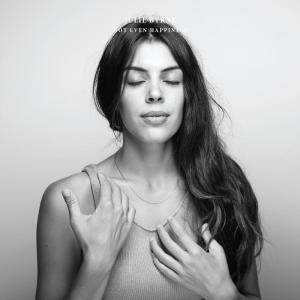
18
Julie Byrne
Not Even Happiness
Ba Da Bing! / Basin Rock
“Ambient folk” is a rather trendy and obnoxious-sounding descriptor, but there’s really no other way to describe Julie Byrne’s lovely, lilting arrangements. The Buffalo, NY native blends the understated style of Nick Drake and early Joni Mitchell with the aesthetic of Brian Eno’s pioneering ’70s work, channeling both into an inimitable universe of her own design. On Not Even Happiness, we hear little else other than quiet (but dexterous) guitar, bits of wispy synthesizer and Byrne’s ethereal voice – the voice of a peaceful yet restless wanderer, seeking meaning and permanence in her fleeting life and finding it through her connection with nature and with those she loves. Hers is an earthy, gorgeous world of immaculate serenity, a powerful refuge from the solid walls of noise that wedge their way into our brains daily and vie for our attention. Once you’ve settled into that world, the look of beatific bliss spread across Byrne’s face on the album cover may very well be your own.
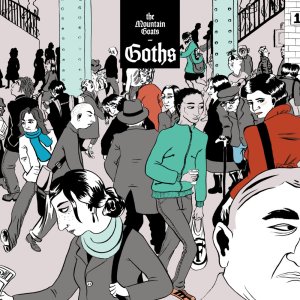
17
The Mountain Goats
Goths
Merge
The case for John Darnielle as the finest musical raconteur of his generation is a strong one: His characters are vibrant and vividly realized, and each of his records reads less like an album than like a collection of short stories. What makes his songwriting truly unique, however, is his unparalleled knack for drawing lyrical beauty from the seemingly insignificant moments of everyday life. For the magnificent Goths – his sixteenth studio effort and his first entirely sans guitars – Darnielle draws inspiration from his youth, growing up listening to Siouxsee and the Banshees and the Cure on KROQ-FM and seeking out the company of society’s loners and outcasts. While the songs themselves are far more indie-folk than Gothic, his lyrics evoke masterfully the pain, angst, and melancholia of goth culture’s adherents – and the ever-present specter of death that fuels their black fire. From the doomy opener “Rain in Soho” to the heart-rending ballad “Andrew Eldritch is Moving Back to Leeds” (that’s the lead singer of Sisters of Mercy, kids) to “Abandoned Flesh” (an elegy for the long-forgotten Gene Loves Jezebel), Darnielle lets his narratives-within-a-narrative flow beautifully, his crackling, energetic vocals giving voice to the voiceless masses. Goths is an album about death, about life, and about the triumphs and tragedies in between – all told with an inimitable grace that could only come from a mind as introspective and brilliant as Darnielle’s.
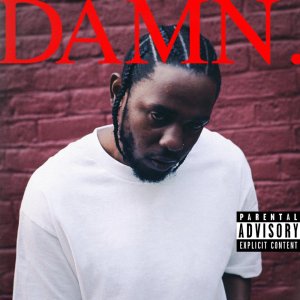
16
Kendrick Lamar
DAMN.
Interscope / Top Dawg
DAMN., Kendrick Lamar’s fourth studio album in six years, opens with an understated spoken word bit from the Compton native atop soft, funky orchestration – sounds that would fit quite comfortably on his 2015 magnum opus To Pimp a Butterfly. Immediately after, we get an abrupt shift into the barebones riot act of “DNA.,” setting the pace for much of the album’s remainder and letting us know we’re in for an entirely different listening experience altogether. Skeletal, pseudo-trap beats buzz and snap in the background as Lamar – still easily the most gifted MC working today – unleashes some of the most direct, unadorned flows of his career on boldface-titled bangers like “HUMBLE.,” “FEAR.,” and “LOYALTY.” His unmistakable voice shifts effortlessly between lethargic, understated drone and frantic near-scream as he philosophizes upon the experience of black America in 2017 and ponders his own place within its grand scheme. As with life itself, it’s tough to draw any definite conclusions from this colorful, jagged record at the outset, but piecing the puzzle together over subsequent listens (tracklist reversed and otherwise) is what makes the experience so exhilarating. Life, as our man Mr. Duckworth puts it on the track that bears his real surname, is truly “one funny motherfucker.”

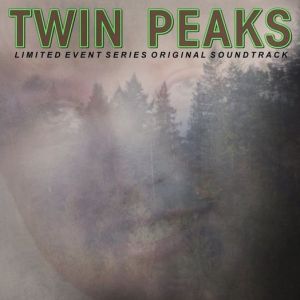
15
Various artists
Twin Peaks (Music from the Limited Event Series)
Twin Peaks (Limited Event Series Original Soundtrack)
Rhino
It’s only fitting that the best film of the year would have the best film soundtrack of the year. This is doubly true considering the vital role of music throughout David Lynch’s oeuvre – not least of all Twin Peaks. The long-awaited third season of Lynch’s groundbreaking soap-noir drama saw the writer-director unspooling some of his most feverish avant-garde nightmares to date for the small screen as the show transcended cinema and television to become an epic treatise on life, death, the afterlife, good, evil, and how maybe Jim Belushi isn’t such a hack after all. But as free-floating and frenetic as The Return often seemed, Lynch leaves nothing to chance in terms of sound design; every note we hear is crucial to the communication of his vision, and each of the dual soundtracks works surprisingly well as a cohesive unit. Lynch expertly books the Twin Peaks roadhouse with an array of artists both new and familiar who update the local aesthetic for a new generation, from the cinematic synthpop of Chromatics and Au Revoir Simone to the ethereal folk of Lissie, Sharon Van Etten and the Cactus Blossoms. Caustic cuts from the Veils and Nine Inch Nails sit comfortably alongside doo-wop staples as sung by the Paris Sisters and the Platters, and Lynch even makes some space for original-series muses Julee Cruise and James “James” Marshall. For the original score, Lynch reunites with his old partner in melancholic crime Angelo Badalamenti (along with engineer Dean Hurley and Chromatics’ Johnny Jewel), concocting newer, darker strains of the mutated ambient jazz that populated the original series and revisiting classic nuggets like the goofy, menacing “Audrey’s Dance.” Throw in Krzysztof Penderecki’s scathing “Threnody for the Victims of Hiroshima” as accompaniment for nuclear Armageddon, and you’re left with a listening experience that’s as glorious and disorienting a mind-fuck as the cult phenomenon that spawned it.

14
Goldie
The Journey Man
Metalheadz
Over two decades removed from his 1995 masterpiece Timeless, the U.K. drum and bass hero (and recent card-carrying member of the OBE) proves with The Journey Man – his first proper record in ten years – that he hasn’t forsaken an ounce of his ingenuity or ambition since then. Goldie’s airtight, extravagantly orchestrated soundscapes remain incredibly, interdimensionally hip, and while the lightning-fast breakbeats, jazzy vocals and trancelike synths and strings that dominated Timeless still abound, his vision feels even more cohesive, and he’s rarely sounded like he’s having as much fun as he does here. Play this record at a rave or a meditation session and it won’t sound out of place. One of the most unexpected triumphs of the year, the 105-minute epic is, indeed, a Journey, but one that’s entirely worth taking.

13
Dirty Projectors
Dirty Projectors
Domino
Dirty Projectors is the kind of post-breakup album only Dave Longstreth could create. He splatters his canvas with brooding, glitchy soultronica, utterly deformed samples and spastic, warped vocal harmonies to mirror the alienated frenzy hopping around his brain. He experiments with the R&B side of his signature yelp on tracks like the slippery, chaotic “Death Spiral” and the devastatingly blunt “Winner Take Nothing,” while frothy, slow-burning opener “Keep Your Name” renders his voice all but unrecognizable as he ruminates on love’s labors lost (“I don’t know why you abandoned me/You were my soul and my partner”). His arrangements bluster and jolt in myriad unexpected directions, making for a delightfully strange and disorienting listening experience. It’s far and away the darkest release under the DP name, but at the same time Longstreth manages to let some glimmers of hope creep in, no matter how manic and twisted things get. He’s clearly having a rough time, but he’ll be okay as long as he keeps following the light.

12
Homeshake
Fresh Air
Royal Mountain / Sinderlyn
“Kissing, hugging, making love and waking up and getting high”: This is the mantra that informs the woozily funky lo-fi R&B of Peter Sagar. On Fresh Air, his third LP as Homeshake, the veteran Mac DeMarco sideman crafts a succession of enticingly slick, lethargic dreamscapes as the backdrop for his subtle explorations of the fleeting highs and lingering lows of modern love. Armed with whispery, wobbly guitars; buzzing, thumping bass; and a voice that expertly treads the line between soulful release and quiet restraint (and between earnestness and kitschy throwback), he unspools scintillating melodies one after the other. Some of the album’s best moments come along in its middle stretch, when Sagar shifts into complete D’Angelo-esque soul-workout mode on tracks like “TV Volume” and “Getting Down Pt. II.” Fresh Air is an endearing and often lovely little work that provides an ideal soundtrack for – well, just read the first sentence again.

11
Blanck Mass
World Eater
Sacred Bones
Benjamin John Power, one-half of UK noise-psychtronica weirdos Fuck Buttons, explores the darker side of his idiosyncratic oeuvre under the Blanck Mass moniker. With World Eater, Power presents us with a soundtrack for the hippest, most abjectly terrifying post-apocalyptic horror flick never made—as well as a grim commentary on our own tempestuous times. Opener “John Doe’s Carnival of Error,” with its faintly menacing yet soothing organ grind, serves as the disarming calm before the hellfire descends. “Rhesus Negative” is a Depeche Mode instrumental on a bad acid trip, all twinkly synths and paranoia; the percussive noises on “Please” and “The Rat” ape murderous factory equipment and clattering silverware. The seven tracks rumble, screech and claw at the barren ground, sprawling every which way but never meandering—darkly beautiful and strangely melodic. Power amps up the psychotic spectacle with his impressive use of the human voice, injecting his scorched-earth visions with chaotically spliced vocal samples and howling choirs of damned souls. It’s progressive techno at its most adventurous and thrillingly theatrical—rife with the sort of all-consuming darkness that can only precede the light of a better tomorrow.

10
The Magnetic Fields
50 Song Memoir
Nonesuch
Just because Stephin Merritt has passed the half-century mark doesn’t mean he’s stopped approaching his music like a gleeful, twinkly-eyed kid. His Tin Pan Alley-by-way-of-Kraftwerk-meets-Jonathan Richman songwriting continues to sharpen with age, and 50 Song Memoir serves to remind us that he’s both a gifted raconteur and a masterful arranger. Never one to back down from an ambitious creative writing exercise (see 69 Love Songs), Merritt chronicles the first five decades of his life over the course of 150 minutes and fifty tracks (labeled by year for your convenience). In his unmistakable baritone, he regales us with erudite tales of his first fumbling forays into the worlds of religion (which he ultimately rejects outright, much to his Ethics prof’s chagrin), love (which he’s not so great at), and music (from the terrible bands he formed as a youngster to the first inklings of a career in electronica), stopping here and there to deliver withering jabs at his flighty beatnik mom’s good-for-nothing boyfriends. He and his bandmates descend upon a bevy of instruments ranging from fairground organ to ukulele to autoharp to any number of magnificently orchestrated synthesizer flourishes. It’s quirky to a fault, to be sure – but what’s always made the Magnetic Fields truly great is that beneath all the wry witticisms and idiosyncratic deadpannery, there’s always an unflappable sincerity – and it comes through strongest on Memoir when Merritt talks of the death of his friend Elliott Smith (“’07 In the Snow-White Cottages”) or his bouts of melancholia and suicidal thoughts (most of the album, really, but especially “’97 Eurodisco Trio”). Even “’15 Somebody’s Fetish,” ostensibly a cheeky ode to sexual kinks, eventually transforms into a touching meditation on finding a love of one’s own. It all amounts to an extraordinary celebration of the grand tragicomedy of life itself – and a wondrous, wacky, lovable glimpse into the mind and soul of one of the world’s greatest living tunesmiths.
9
Jansport J
p h a r a o h
blackwhitegoldville
Every single review I’ve read of Jansport J’s freewheeling, vibrant mini-hip-hopera (my own included) has drawn connections between him and another, more legendary J. These comparisons, of course, are not without merit, as Justin Williams’ work certainly owes plenty to the seminal Donuts. But let’s look past all that for a minute and consider the remarkable ingenuity and singular vision it takes to make a record like p h a r a o h. J’s funky, heartfelt and surprisingly fluid collection of song nuggets redefines the concept of the instrumental hip-hop album itself and explores the cratedigging genre’s potential for storytelling – in this case, our story takes the form of a ride on the L-train through NYC, an opportunity to breathe in the life and personality of the city. Old school boom-bap rides comfortably alongside psychedelic keys and analog synths, with an abundance of soul samples and vocal harmonies scattered throughout. J’s dynamic use of the human voice on tracks like “Peace, Pt. I” and “12” make p h a r a o h the warmest, most organic aural experience of its kind we’ve heard in a while. Just sit back, press play, and let it take you away.
8
Father John Misty
Pure Comedy
Sub Pop
Josh Tillman has become something of a punching bag among the music journalism community, with the critiques running the gamut from “his facial hair looks dumb” to “he’s an arrogant, smug, self-indulgent jackass-troll who embodies everything despicable about white hipster culture.” What people seem to forget in their discussions of Tillman, however, is the music. The public’s varied opinions of the man himself don’t change the fact that he’s one of the greatest and most imaginative songwriters of this infant century. The expansive, ambitious Pure Comedy could be used as fuel for either side of the Father John Misty debate, but still, it’s a damn fine record. Enlisting the aid of legendary orchestral arranger Gavin Bryars, Misty channels the majestic strings, soulful piano melodies and prickled wit of Randy Newman and early Elton John in a series of scathing critiques on technology (“Things It Would Have Been Helpful To Know Before the Revolution”), liberal self-righteousness (“Ballad of the Dying Man”), and even the elite group of “L.A. phonies and their bullshit bands/That sound like dollar signs and Amy Grant” of which he counts himself a member (the 13-minute centerpiece “Leaving L.A”). Tillman’s attempts to cement his status as a social satirist for the millennial age vary in their success (the rather troubling “both sides” rhetoric of “Two Wildly Different Perspectives” could double as a mission statement for centrist Democrats), but when the record fails, it does so nobly enough that it’s hard not to fall in love with it anyway. At its best, Pure Comedy is a sweeping, gorgeous and deeply affecting look at the absurd state of modern humanity, as well as a call for positive change. As Tillman croons at the end of the title track: “I hate to say it, but each other’s all we’ve got.”

7
Björk
Utopia
One Little Indian
Björk is in love, and she doesn’t care who knows it. After 2015’s cataclysmic post-breakup scorcher Vulnicura, the shapeshifting Icelandic icon exhibits a complete sea change, gazing doe-eyed upon a lush, shimmering Utopia brimming with chirping birds, cosmic harps and endless romantic possibilities. Reteaming with Venezuelan producer Arca and enlisting the aid of a 13-piece flute ensemble, she unfurls intoxicating, warbling incantations over beds of shivery folktronica. It all begins with the euphoric “Arisen My Senses,” wherein the simplest show of affection – a kiss – provides the impetus for Björk’s sensual and sexual reawakening. Though she’s certainly never shied from portraying sexuality in her work, Utopia is all strap-on dicks and heart-shaped vulvae, all orgasmic bliss. By extension, it’s one of her most organic, human-sounding records – she manages to unearth the deep beauty in “two music nerds” texting and sending each other MP3s (“falling in love to a song”) on “Blissing Me,” and over the 10-minute span of the bestial nature walk “Body Memory,” she finds healing from past wounds via self-reliance (with the help of a rapturous threescore-strong choir). After the pitch-black catharsis of her previous record, Ms. Guðmundsdóttir is finally ready to live again, and both she and we are made all the better for it.

6
LCD Soundsystem
american dream
DFA / Columbia
Plenty of musicians released records this year that reflected the anxiety and anger permeating Trump’s America, but few did so with as much nightmarish, devastating clout as James Murphy on the viciously bold american dream. A reunion record in name only, dream makes it feel like Murphy’s enclave of nervous indie punks never left. It’s a recklessly catchy art-dance vision of a dystopian future that may not be so far away – a glimpse into Murphy’s personal anxieties as well as the public’s. Now pushing 50, Murphy ruminates on his inevitable midlife crisis and the cruel hands of time (“I’m just not dangerous now/The way I used to be once/I’m just too old for it now/At least that seems to be true”). And yet, LCD sound more ferocious and vital than ever, drawing from the giants of New Wave for songs as danceable as they are haunting (see the rattling, discordant Talking Head-trip “other voices” and the glitzy slow-dance waltz of the title track.) Murphy’s clarion calls on “i used to” hearken back to a time when Bono actually gave a shit, and the robotic “tonite” and the Springsteenian sheen of “call the police” stand among the most electrifying, moving performances of his career. The ghosts of the prior year’s departed loom large over the record, from Suicide’s Alan Vega on the shimmering “oh baby” to the ominously droning 12-minute Bowie tribute “black screen”; their influence only adds to the feel of heavy sobriety throughout. dream vibrantly paints a tense present and an uncertain future for both the band and the country they live in – but, as yet another giant we lost in 2016 might have put it, if we’re all going to die, we might as well just dance our lives away.

5
St. Vincent
MASSEDUCTION
Loma Vista
A decade in, Annie Clark remains, from a vocal and lyrical standpoint, one of the most unique and fascinating voices in modern rock, and record no. 5 MASSEDUCTION is the most fearless, vicious and fully-realized manifestation of her twisted art-pop vision to date. Here Clark, working with a Holy Trinity of sought-after producers, takes everything great about her first four studio efforts and cranks it up to 11, resulting in a sequence towering synth-glam hymns that are both immaculately polished and miraculously avant-garde. The robotic chorus of the title track – “I can’t turn off what turns me on” – doubles as a statement of purpose, the artist herself having described its motif as “dominatrix at the mental institution.” Frenetic, unbelievably catchy cuts like Hollywood excess ode “Los Ageless” and the Sounwave-aided “Pills” – which sounds not unlike a dystopian commercial jingle – explore the many things in our absurd, overwrought world that get us off, with exquisite punctuation from Clark’s glorious voice and face-obliterating guitar shreds. But it’s not all New Wave paranoia – stripped-back ballads such as the mournful, pedal-steel driven “Happy Birthday, Johnny” and the glorious “New York” provide a new depth of meaning to her unflinchingly honest and often hilarious lyrics. Simply put, there are very few artists firing on all cylinders like St. Vincent, who has, with MASSEDUCTION, rightly earned her place among the true pop visionaries of our time.

4
Future Islands
The Far Field
4AD
The sublime theatricality of Baltimore’s Future Islands just keeps getting better with each record. The Far Field isn’t exactly a major shake-up of their signature New Wave-influenced sound, but what is different here is the trio’s ability to dig deep into the heart of their music, exuding levels of emotion and wide-eyed expression never thought possible. With help from the deft hand of producer John Congleton, the band delivers burst after burst of rapturous, euphoric sound. Sam Herring’s voice remains one of the most unique and inimitable in modern rock, and here he leaves no atom of himself unexposed, passionately bellowing about his hopes, his insecurities, his longing for connection with nature and with his fellow human beings. Bassist William Cashion and synth wizard Garrit Welmers, meanwhile, busily construct a lushly-orchestrated backdrop that intensifies and solidifies the drama of Herring’s vivid vocal performances. Like Singles before it, The Far Field is an instant classic – a collection of perfectly-executed, emphatically realized songs from three musicians with a distinctive passion not only for their craft, but for the human experience itself.
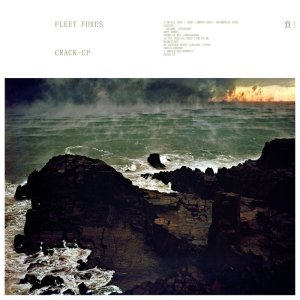
3
Fleet Foxes
Crack-Up
Nonesuch
Whenever an artist returns from an extended hiatus, fans’ expectations for new music from that artist can be impossibly high. When that artist is Robin Pecknold, who crafted a pair of landmark, generation-defining indie rock records with his band Fleet Foxes before his embarkment to Columbia University, those expectations are damn-near stratospheric. Luckily, Pecknold is nothing if not a forward thinker; he took his downtime seriously and eventually rejoined the fold of the Seattle folk outfit with the life experience and introspection needed to create the most complex, daring, and reflective Fleet Foxes record to date. Crack-Up quite literally picks up where Helplessness Blues left off, with lethargic guitar and voice giving way to a sweeping panorama of sound. The album revels in what originally made the group great – the rumbling percussion, the Laurel Canyon-echo harmonies, the wildly varied instrumentation, the masterfully-navigated dynamic shifts – while also signifying a giant musical step forward. The band draws from African and Middle Eastern music to craft a familiar yet entirely new sound, abounding with reedy brass and woodwinds, thunderous piano, lively strings, flickering electronic programming, and rapid time-signature changes. The tracks sprawl and ramble, mirroring their bi-coastal creation (including, among other locations, the legendary Electric Lady Studios). Lyrically, Pecknold reflects in his own poetic, erudite way upon the turbulent climates within his country and personal life. “Cassius, Naiads, Cassadies” reflects on the cruelties of a white patriarchal society towards its “others,” from the deaths of Alton Sterling and Philando Castile (“Life makes short work of all I see…Red and blue, the useless sirens scream”) to the daily terrorizing of women (“Who turned you so against you?”) On the pastoral “If You Need To, Keep Time On Me,” Pecknold urges us to stick together as we continue to face our uncertain future. The record’s centerpiece, the gorgeous, anthemic “Third of May / Ōdaigahara,” examines the frontman’s strained relationship with bandmate Skye Skjelset and transforms into a meditation upon humanity and its shared experiences (“I am only owed this shape if I make a line to hold”). Crack-Up is beautiful and monstrous, harrowing and soothing, reckless and riveting—a monument to fearlessness in art and life. So, yeah—it lives up to the hype.
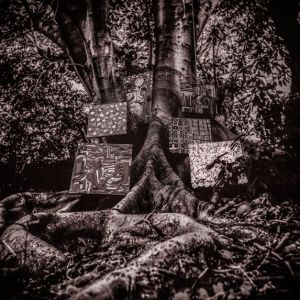
2
Kamasi Washington
Harmony of Difference (EP)
Young Turks
The supernaturally gifted saxophonist-composer blew no shortage of minds two years ago with his sprawling solo debut The Epic. His follow-up EP is considerably shorter than its three-hour, 17-track predecessor, but Washington, virtuoso that he is, successfully packs the very same level of intensely jubilant cosmic rapture into its half-hour runtime. Playing alongside some of the brightest talents in the modern jazz stratosphere – Tony Austin on drums, Brandon Coleman on keyboard, Miles Mosely and Steven “Thundercat” Bruner on bass, et al. – Washington uses a disarmingly simple phrase-variation formula to explore seemingly every facet of human experience (“Desire, “Humility,” “Integrity,” etc.), visiting and revisiting similar melodies in radically different ways throughout six contiguous movements. The musicians are proud to share the same spotlight, and it’s truly beautiful to hear them assemble their fantastical sonic worlds together. This generous creative give-and-take is most evident on the 13-and-a-half-minute centerpiece “Truth,” which opens with a light rhythm section riff and steadily adds layer upon layer until reaching a glorious climax complete with string quartet, choir, and volcanic drum fills. Its complexity will impress jazz purists, and yet the music is so accessible – indeed, so human – that even total novices can catch the drift. Intoxicating and perfect in just about every way, Harmony makes a superb argument for Washington’s placement among jazz royalty – especially for those without three hours to spare.
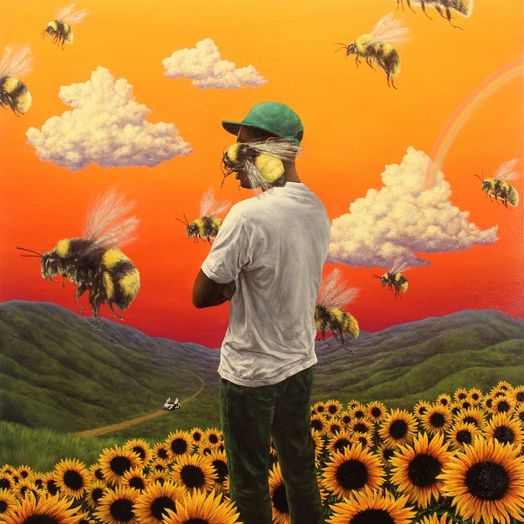
1
Tyler, the Creator
Flower Boy
Columbia
With Flower Boy, the Odd Future mastermind and one-time clown prince of alternative hip-hop is finally making the music we always knew he could make. The Stevie Wonder/Marvin Gaye-inspired neo-soul he toyed with on 2015’s Cherry Bomb comes to full, magnificent fruition as lushly orchestrated backdrops and a who’s-who of inspired collaborators buttress some of the most personal, introspective bars the 26-year-old has ever unleashed. (Of course, he hasn’t abandoned his horrorcore roots completely; he and A$AP Rocky go full mad-scientist on the raucous, braggadocio-stuffed jaunt “Who Dat Boy.”) We find him ruminating on his success and his place in the musical pantheon (“How many raps can I write until I get me a chain/How many chains can I wear ‘til I’m considered a slave?”), as well as his own anxiety and depression, doubt and isolation (most effectively on the devastating single “911 / Mr. Lonely”). Yet for all its bleakness, much of the album bears an audible joy – it doubles as a coming-out party for Tyler, whose lyrics have had fans launching “is-he-or-isn’t-he” speculations for years. They need wonder no longer upon hearing tracks like “Where This Flower Blooms” (featuring pal Frank Ocean) or the sultry love ballad “See You Again,” which burst with the jubilation (and confusion) of a man finally starting to live his own truth, his unadorned but affecting vocals mirroring the awkward, fumbling beauty of his brave, queer new world. Flower Boy is bold and beautiful – an exploration of life in all its joys, loves and fuck-ups that remains full of hope even as the darkness continues to rear its head. In other words, it’s the record the world needed in 2017. Thank you, Tyler. Keep on rocking, rolling, blooming and growing.
Honorable Mentions

Julien Baker / Turn Out the Lights (Matador)
Neil Cicierega / Mouth Moods (Self-released)
Drake / More Life (OVO Sound / Young Money / Cash Money / Republic)
Foxygen / Hang (Jagjaguwar)
Kesha / Rainbow (Kemosabe / RCA)
Lorde / Melodrama (Lava / Republic)
Randy Newman / Dark Matter (Nonesuch)
Paramore / After Laughter (Fueled by Ramen)
Moses Sumney / Aromanticism (Jagjaguwar)
The xx / I See You (Young Turks)
